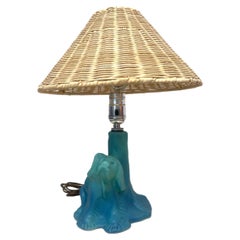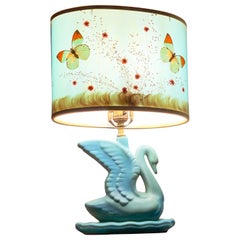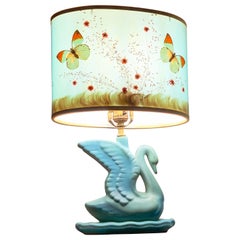Van Briggle Shade
Vintage 1940s American Other Table Lamps
Metal
Mid-20th Century Unknown Mid-Century Modern Table Lamps
Ceramic, Plastic
Recent Sales
Mid-20th Century American Art Nouveau Table Lamps
Pottery
Mid-20th Century American Art Nouveau Table Lamps
Pottery
Van Briggle for sale on 1stDibs
Van Briggle, an American artist of Dutch descent, was established as a world-class painter in Europe. Having been trained at the finest academies there, and with paintings accepted by the Paris Salon, he received the highest honors for a painter in his day. Yet his artistic passions would ultimately lead him away from his brush, canvas and easel toward another artistic pursuit that would ultimately define his genius. Though Artus was a brilliant painter, his artistic passions were most eloquently expressed in the forms and colors of one of history’s oldest arts - pottery. From his years as a celebrated artist at the famed Rookwood Pottery in Ohio, he knew first-hand the extraordinary range of expression an artist could achieve with the potter’s materials. His pursuit was the creation of exquisite satin matte glazes, like those he’d seen on ancient Chinese masterworks, in a palette of glorious colors, never achieved by any artist in modern times. The materials this brilliant artist would use for his greatest artistic pursuit would be minerals from the earth - clays, feldspars, oxides - and the glowing orange flames of a fiery kiln.
When transformed by the creative mind and the skilled hand, these materials become the essence of both humanity and nature blended in unity. Clay and glaze are indeed extravagant media, offering the artist a lifetime of challenges and rewards. Artus, however, didn’t have a lifetime - tragically, he had contracted tuberculosis and though a relatively young man, his future was uncertain. Artus had achieved some success in discovering a formula for these beautiful matte glazes prior to his arrival in Colorado but he continued his work there, seeking a standard of perfection not yet achieved. Pottery is a melding of art and science, and during the time when he conducted his experiments, Artus knew that success could not come without the patience of a scientist and the passion found in all great artists. He pursued his vision with tireless effort, though the effects of failing health often interrupted his progress. No specific date is recorded, but one day in the spring of 1901 he reached into the kiln, with the anticipation known well by countless potters throughout the ages, and finally held in his hands the perfect, rich, matte-glazed pottery he had sought for so long - the first pieces created in centuries, the first ever on this side of the world. Against the odds of failing health and a pursuit which no western artist had ever achieved, he succeeded; his passion was realized - a lost art was now reborn. The world would once again see and touch the soft marble-like glazes first known by ancient Chinese masters half a world and so many generations away.
When you hold in your hand a piece of fine artistry and craftsmanship, a human creation with elegant lines and a sensual surface - something experienced by the eyes and hands and ultimately felt by the soul, you’ll know what Artus Van Briggle was seeking - and what he ultimately achieved. He lived to see his artistic passion fulfilled before his own mortality could eclipse his dream. Though the sun setting on his own life, a new era was on the horizon for one of the oldest arts in history. Once perfected, Artus Van Briggle’s exquisite new glazes graced his elegant Art Nouveau pottery designs which were sent across the Atlantic and, when shown to Europe’s best art judges, were proclaimed - A supreme discovery in modern ceramics. Soon, art critics across the continents marveled at his works, lavished him with praise, and brought international acclaim to this quiet American artist on the Colorado frontier. Before long, he succumbed to tuberculosis and died there in the shadow of the Rocky Mountains, but not before receiving word that when shown at exhibitions here in the United States and in the Salons of Europe, his creations had won their highest awards.
Van Briggle Pottery is the living heritage of an extraordinary artist whose heart and hands were given only half a lifetime, and to his wife, Anne, whose own dedication and fine artistry after Artus’ death carried their vision to success in its earliest years. Together, they left a timeless and permanent imprint on the tradition of American art pottery. With each passing year and with each new piece created, their artistic legacy continues, a legacy known as Van Briggle - a Tradition in American Art Pottery since 1899.
Finding the Right Table-lamps for You
Well-crafted antique and vintage table lamps do more than provide light; the right fixture-and-table combination can add a focal point or creative element to any interior.
Proper table lamps have long been used for lighting our most intimate spaces. Perfect for lighting your nightstand or reading nook, table lamps play an integral role in styling an inviting room. In the years before electricity, lamps used oil. Today, a rewired 19th-century vintage lamp can still provide a touch of elegance for a study.
After industrial milestones such as mass production took hold in the Victorian era, various design movements sought to bring craftsmanship and innovation back to this indispensable household item. Lighting designers affiliated with Art Deco, which originated in the glamorous roaring ’20s, sought to celebrate modern life by fusing modern metals with dark woods and dazzling colors in the fixtures of the era. The geometric shapes and gilded details of vintage Art Deco table lamps provide an air of luxury and sophistication that never goes out of style.
After launching in 1934, Anglepoise lamps soon became a favorite among modernist architects and designers, who interpreted the fixture as “a machine for lighting,” just as Le Corbusier had reimagined the house as “a machine for living in.” The popular task light owed to a collaboration between a vehicle-suspension engineer by the name of George Carwardine and a West Midlands springs manufacturer, Herbert Terry & Sons.
Some mid-century modern table lamps, particularly those created by the likes of Joe Colombo and the legendary lighting artisans at Fontana Arte, bear all the provocative hallmarks associated with Space Age design. Sculptural and versatile, the Louis Poulsen table lamps of that period were revolutionary for their time and still seem innovative today.
If you are looking for something more contemporary, industrial table lamps are demonstrative of a newly chic style that isn’t afraid to pay homage to the past. They look particularly at home in any rustic loft space amid exposed brick and steel beams.
Before you buy a desk lamp or table lamp for your living room, consider your lighting needs. The Snoopy lamp, designed in 1967, or any other “banker’s lamp” (shorthand for the Emeralite desk lamps patented by H.G. McFaddin and Company), provides light at a downward angle that is perfect for writing, while the Fontana table lamp and the beloved Grasshopper lamp by Greta Magnusson-Grossman each yield a soft and even glow. Some table lamps require lampshades to be bought separately.
Whether it’s a classic antique Tiffany table lamp, a Murano glass table lamp or even a bold avant-garde fixture custom-made by a contemporary design firm, the right table lamp can completely transform a room. Find the right one for you on 1stDibs.



